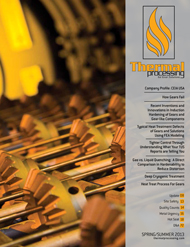Have you ever hit a rock or other hard projectile while cutting your lawn? Have you noticed that the blade is dented, not broken or cracked? How about all of those fasteners used to hold the trim and cosmetic panels on your car? Think about any of the thousands of clips and clamps that exhibit a springing action that you encounter every day. The manufacturing process that enables all of those mower blades and strange-looking fasteners to function without breaking is: Austempering.
I’ve briefly discussed austempering before—the process of quenching to above the Martensite (Ms) point in molten nitrite/nitrate salts, where bainite in steel and ausferrite in cast irons is the transformation product. Austempering is the process that produces a variation of bainitic microstructures in ferrous alloys that is chemically and isothermally driven.
Most fasteners are stamped and formed from mild low-alloy steels, which contain enough carbon to produce adequate hardenability to facilitate missing the pearlite nose of the TTT curve, the same requirement to create martensite when quenched in oil. Instead of cooling to the temperature [Ms] point, in austempering the component is held just above the Ms point, approximately 500°F to 700°F [260°C to 371°C] and held there to form 100% lower bainite. Upper bainite, a higher-temperature form of bainite, is softer with diminished properties. The temperature range suitable for forming lower bainite depends on the carbon and alloy content of the material. Lower bainite’s transformation for steel, cast iron, and more specifically austempered ductile iron [ADI] will always be closer to the Ms point. The higher the alloy and carbon content, the lower the Ms point, thus the lower bainite temperature. As the alloy content increases, the hold time will increase; typically high-alloy materials are required only in large sections requiring more hardenability.
The advantage of austempering in steel is the toughness and ductility improvement over the similarly tempered hardness of quenched steel; tempered martensite is still martensite and, as such, retains its lower impact strength. Figure 1
Because a finite time for transformation to bainite is required, the quench tanks and part removal systems become a design consideration. Because fastener sections are thinner (usually less than ½” [13 mm]), they are perfectly suited for heat treatment in continuous mesh belt furnaces. Conversely, since austempered ductile iron (ADI) parts are generally larger, having seen applications like transmission cases, drivetrain components, gears, and shafts for example, they are processed in special integral quench batch furnaces. In addition, the higher alloy ADI will require longer soak times in the salt quench, making the heavier-duty continuous cast-link belt furnaces and their associated quench less flexible, thus less suitable.
Austempering is a through-hardening process not requiring carburizing, although increasing the surface carbon can have beneficial effects, which I’ll detail later. Just as in martensite hardening, the austempered part’s surface must be free from decarburization to provide the expected wear and fatigue resistance.
AFC-Holcroft has long been providing the industry with batch and continuous austempering furnace equipment. Batch systems are coined UBQA—Universal Batch Quench Austemper. Carburizing batch furnaces consist of a hot zone and vestibule/oil quench tank; UBQA’s integrate an intermediate chamber between the hot zone and the salt vestibule/quench. This chamber isolates the molten salt vapor from the hot zone and contains a mechanism to transfer the load uninterrupted from the hot zone to the quench tank. Being a batch system offers the flexibility of holding the load in the salt for various times, accommodating small and large section sizes. Mesh and cast link belt systems have a continuously-running conveyor lifting quenched parts from the tank; this requires the parts to reach the salt temperature and appropriate soak duration prior to being removed from the salt. Sections too massive will not receive the proper hold time as the conveyor is moving at a constant speed. As in oil quench mesh belt furnaces, parts dropping from the belt into the quench chute must cool fast enough while falling through the salt to miss the pearlite nose and reach the bainite region before settling onto the discharge conveyor. Once cooled to the bainite region, no harm comes to parts soaked longer than required (generally speaking), but holding short of the required time will cause martensite to form when the retained austenite cools to below the Ms point upon removal from the salt and washed.
In the U.S., the general rule for oil quench tank volume is one gallon of oil for one pound of the quenched load. Salt, however, is different and can contain several times the volume; however pounds, not gallons, is the measurement of salt. Salt does not vaporize during quenching as does oil, but adequate agitation is still important to create uniform heat transfer around parts. Water can be added in small amounts to salt to increase the quench speed, but the method of addition is generally a proprietary function since, if not done properly, can cause quench speed variations and safety issues.
The evolution of ADI has led to the adaptation of austempering gear components. It’s lighter weight and increased fatigue strength has made the process attractive to automotive and off-road applications. An important advantage of ADI for automotive transmission applications is the sound-deadening effect of ausferrite and graphite-1. Another advantage of bainite and ausferrite in gears is what I call “micro-surface ductility,” the characteristic of bainite’s inherent ductility to mold itself via contact pressure to the mating gear teeth, thereby providing a lower and more uniform transfer force per square millimeter. This unique force transfer technique is achieved in carburized gears by allowing for a high retained-austenite concentration on the gear teeth, resulting in a similar force-spreading affect.
Carbo-Austempering™-2, an endo-gas carburizing process developed by Applied Process Inc.–Technologies Div. has provided a tier 1 supplier about ten percent of its side-gear production for all-wheel drive cement trucks. The process greatly increases the hardness and fatigue strength of ausferrite and bainite and finds additional application in defense-related applications-3.
Since reduced noise is a fundamental requirement of any drivetrain design, bainite and ausferrite’s isothermal nucleation and growth development results in a uniform and predictable volume change that equals about half that of martensite. Its appropriate gear design principles and sound-absorption qualities make ADI an ideal gear material.
Finally, in collaboration with Applied Process, AFC-Holcroft has built the largest integral salt quench batch furnace trademarked the “Monster-™.” It’s designed to process 20,000 Lbs. [9.072 Kg] of steel or cast iron components. With a load size of 84” x 96” x 56” [2050 mm x 2438 mm x 1422 mm] it will be able to austemper huge single fabrications and castings or hundreds of racked parts.
References:
- Contributions from articles by Justin Lefevre and Kathy L. Hayrynen, PhD, Applied Process Technologies Div, Livonia, MI USA
- Carbo-Austempering is a trade mark of Applied Process Technologies Div, Livonia, MI USA
- orrespondence from John R. “Chip” Keough, Chairman, Applied Process Technologies Div, Livonia, MI USA




























